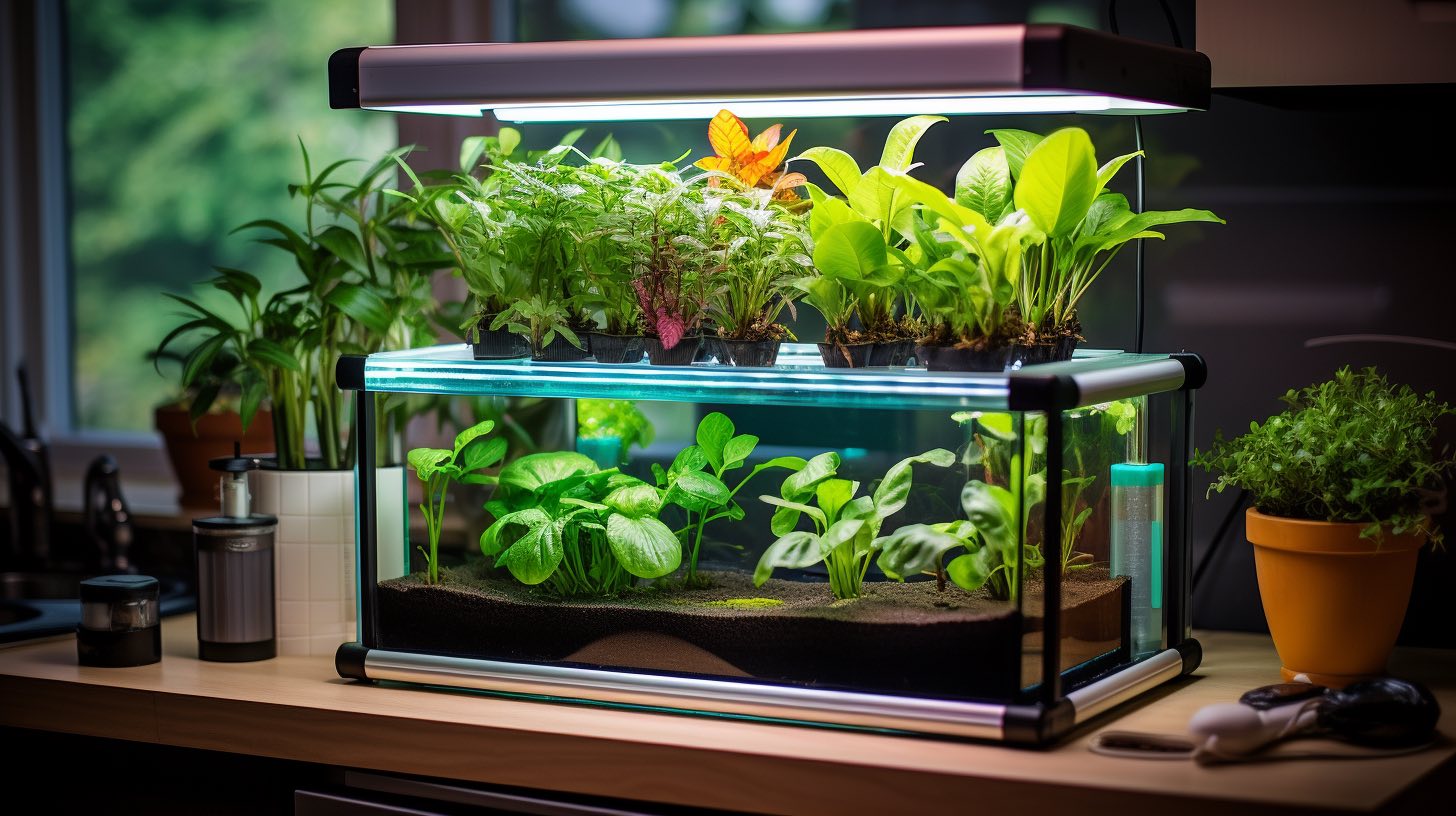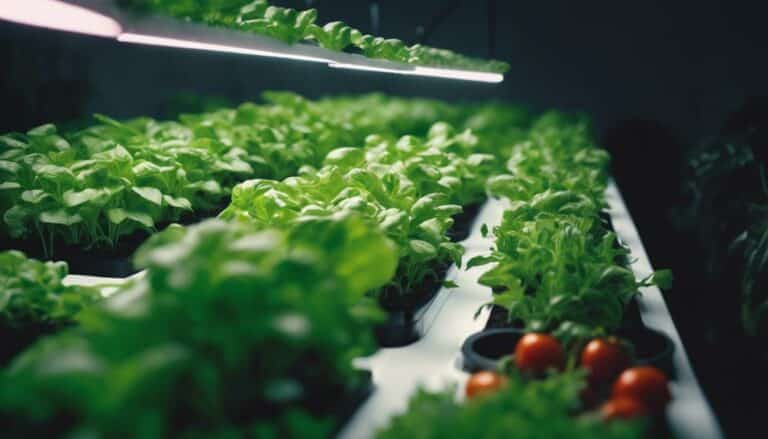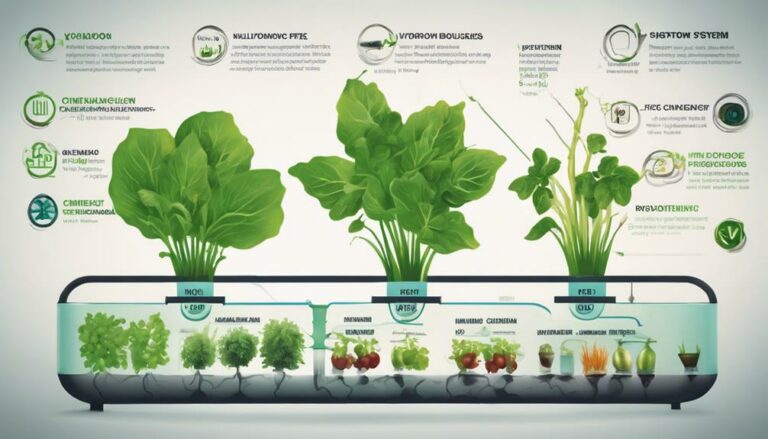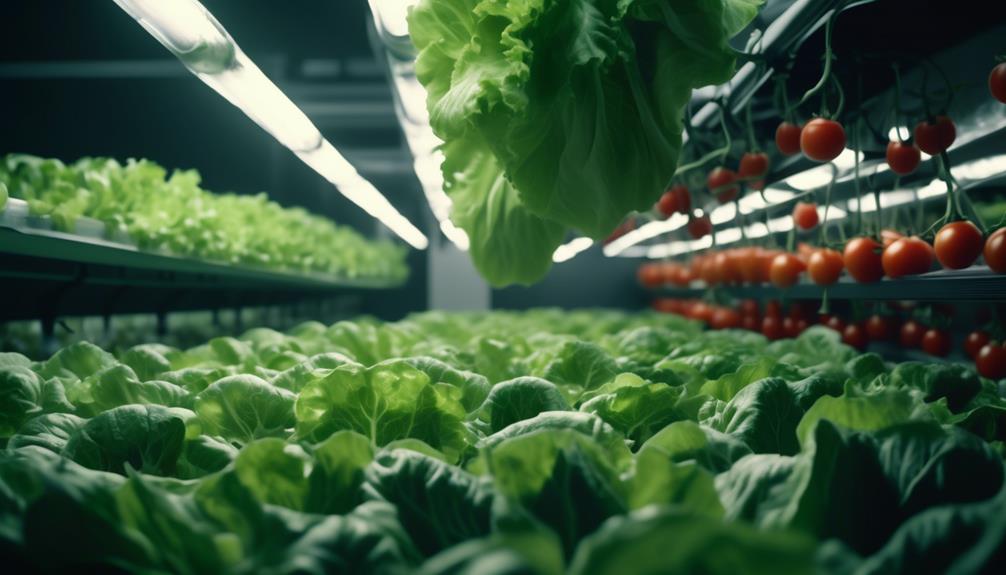I’ve got the ultimate guide for setting up your own ebb and flow hydroponic system. In this article, I’ll walk you through the steps and provide all the information you need to get started.
From selecting the right system to troubleshooting common issues, we’ll cover it all.
So if you’re ready to dive into the world of hydroponics and take your gardening to the next level, let’s get started!
Table of Contents
Key Takeaways
- Consider the nutrient requirements, growth habits, and compatibility of plants with the system’s design.
- Use a combination of coco coir and perlite for the ideal growing medium.
- Position the pump at the bottom of the reservoir for efficient water circulation.
- Regularly adjust flood and drain cycles, monitor nutrient levels, and maintain pH levels for optimal plant growth.
Selecting the Right Ebb and Flow Hydroponic System
I’m considering the various factors involved in selecting the right ebb and flow hydroponic system.
When choosing the right plants for ebb and flow hydroponics, it’s important to consider their nutrient requirements, growth habits, and compatibility with the system’s design. Some plants, like lettuce and herbs, thrive in ebb and flow systems due to their shallow root systems. On the other hand, plants with deep roots, such as tomatoes and cucumbers, may not be suitable for this system.
Troubleshooting common problems in ebb and flow systems is also crucial. Issues like clogged drain lines, uneven flooding, or inadequate drainage can hinder the system’s performance. Regular maintenance, proper nutrient balance, and monitoring the pH levels are necessary to prevent these problems.
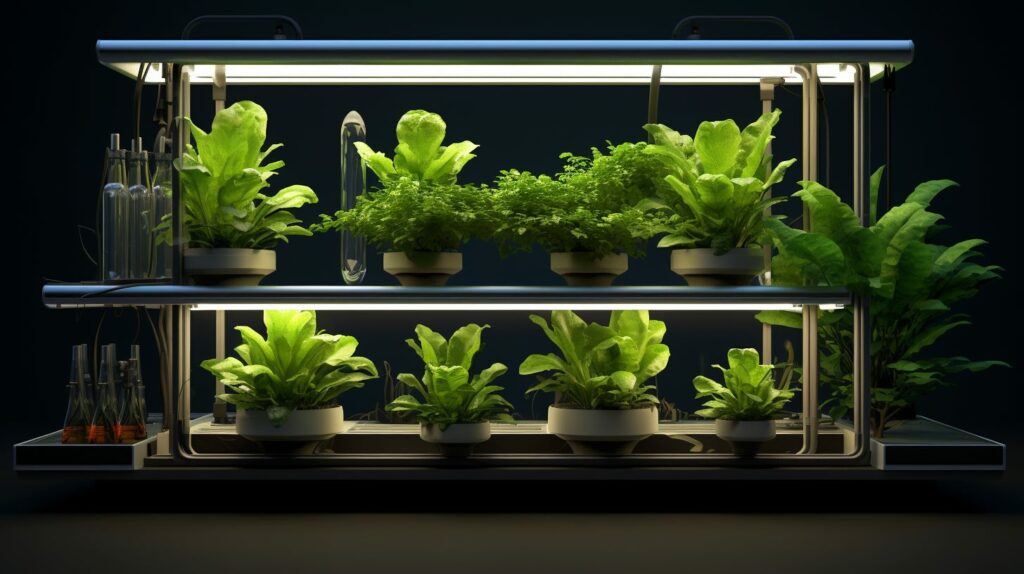
Choosing the Ideal Growing Medium for Your Ebb and Flow System
When it comes to choosing the ideal growing medium for my ebb and flow system, I prefer to use a combination of coco coir and perlite.
This combination provides the perfect balance of water retention and aeration, ensuring optimal root development and plant growth. Coco coir, derived from coconut husks, is an excellent choice as it holds moisture well while also allowing for good drainage. It’s also a sustainable alternative to peat moss.
Perlite, on the other hand, is a lightweight volcanic glass that promotes excellent drainage and aeration. It helps prevent overwatering and allows for proper oxygenation of the roots.
The combination of coco coir and perlite creates a well-structured, nutrient-rich growing medium that promotes healthy plant growth in my ebb and flow hydroponic system.
Setting Up the Reservoir and Pump for Your Hydroponic System
When setting up the reservoir and pump for your hydroponic system, it’s crucial to consider the size of the reservoir to ensure an adequate water supply for your plants.
The pump should be placed in a location that allows for optimal water circulation and oxygenation throughout the system.
Additionally, maintaining proper water levels is essential to provide the necessary nutrients and hydration for your plants’ growth and development.
Reservoir Size Considerations
The reservoir size depends on the number of plants I plan to grow in my hydroponic system. It’s crucial to choose the right capacity to ensure optimal water circulation and plant growth.
Here are three important considerations when determining the reservoir size:
- Plant Density: The number of plants per square foot will determine the amount of water required. For higher plant densities, a larger reservoir is needed to provide sufficient water for all plants.
- Growth Stage: Different growth stages require varying amounts of water. Younger plants need less water compared to mature ones. Adjusting the reservoir size based on the growth stage will ensure efficient water circulation and prevent waterlogging.
- Evaporation and Temperature: Higher temperatures and increased evaporation rates necessitate a larger reservoir to compensate for water loss and maintain a stable water level.
Pump Placement and Function
In my hydroponic setup, I position the pump at the bottom of the reservoir to ensure efficient water circulation throughout the system. This placement is crucial for maintaining optimal plant growth and preventing any issues related to water stagnation or poor nutrient distribution.
By positioning the pump at the bottom, it allows for the continuous movement of water, preventing any potential blockages or airlocks that could hinder the flow. Additionally, this placement ensures that the nutrients are evenly distributed to all the plants in the system, promoting healthy root development and nutrient absorption.
It’s important to regularly maintain the pump to prevent any clogs or malfunctions that could disrupt the water circulation. Regular cleaning and inspection of the pump will help to prolong its lifespan and ensure the efficient functioning of the hydroponic system.
Maintaining Proper Water Levels
Now that we’ve discussed pump placement and function, let’s dive into maintaining proper water levels in your ebb and flow hydroponic system. This is crucial for the health and growth of your plants.
Here are three key steps to help you achieve and troubleshoot water level fluctuations:
- Adjusting Water Flow:
- Start by setting the timer for the flood cycle, ensuring the tray is flooded for the correct duration.
- Monitor the water level during the flood cycle and adjust the pump flow rate if needed.
- Aim for a water level that covers the roots but doesn’t submerge the plants entirely.
- Troubleshooting Water Level Fluctuations:
- Check for any clogs or obstructions in the pump or delivery system.
- Ensure the drain system is functioning correctly to prevent water from overflowing.
- Regularly inspect and clean the float valve to maintain accurate water level control.
Installing the Flood Tray and Drainage System
I’m setting up the flood tray and drainage system for my ebb and flow hydroponic system. This is an essential step to ensure proper water management and prevent waterlogging in the grow bed. The flood tray installation involves placing the tray at an elevated position to allow water to flow back into the reservoir during the ebb phase. The drainage system setup is crucial for removing excess water from the grow bed. To achieve this, I have designed a simple yet effective system using PVC pipes and fittings. Here is a table outlining the components needed for the drainage system:
| Component | Quantity |
|---|---|
| PVC pipes | 2 |
| Elbow fittings | 4 |
| T-joint | 1 |
| End cap | 1 |
Adjusting the Timing and Frequency of Flood and Drain Cycles
To optimize the flood and drain cycles in my hydroponic garden, I adjust the timing and frequency of water flow. This allows me to create the ideal conditions for my plants to thrive.
Here’s how I do it:
- Adjusting flood duration: By controlling how long the flood cycle lasts, I can ensure that the plants receive enough water without causing waterlogging or oxygen deprivation. This is crucial for their overall health and growth.
- Optimizing drain intervals: It’s important to find the right balance between flooding and draining. By adjusting the time between flood and drain cycles, I can prevent the roots from staying submerged for too long, which could lead to root rot or nutrient deficiencies.
- Fine-tuning the frequency: Depending on the type of plants and their growth stage, I modify the frequency of flood and drain cycles. This helps in providing the right amount of water and nutrients at the right time, promoting healthy growth and maximizing yields.
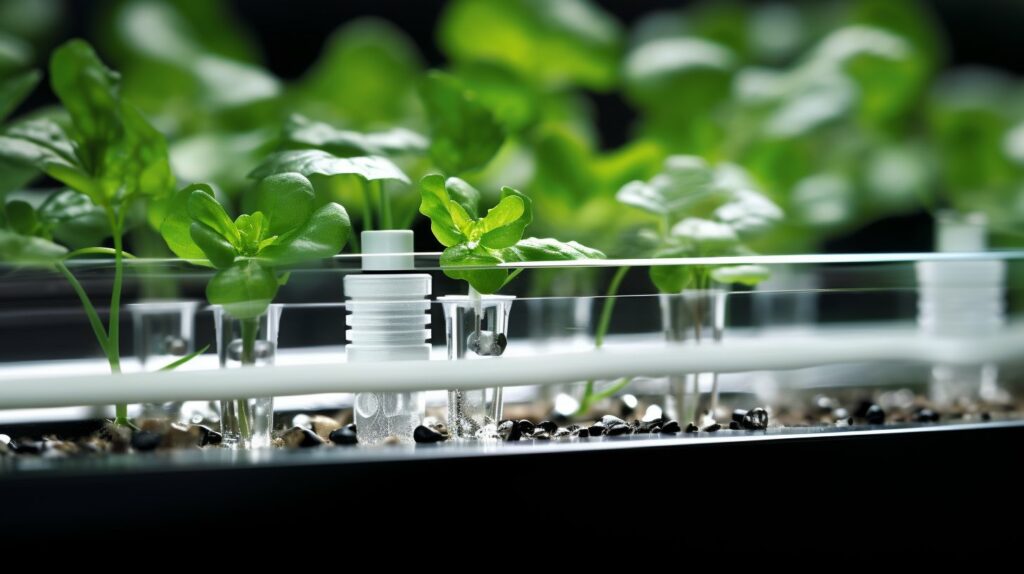
Monitoring and Maintaining Nutrient Levels in Your Ebb and Flow System
Monitoring and maintaining nutrient levels is crucial for the success of my hydroponic garden. Nutrients play a vital role in the growth and development of plants, and any deficiencies can have a significant impact on their overall health and productivity. To ensure optimal nutrient levels, I regularly test my nutrient solution using a reliable testing kit. By monitoring the nutrient levels, I can identify any deficiencies or imbalances and take corrective actions promptly.
To help me track and interpret the results of my nutrient solution testing, I use a table that displays the recommended nutrient levels for different plant stages, nutrient deficiency symptoms, and the appropriate corrective measures. This table serves as a handy reference guide, allowing me to quickly identify and address any nutrient-related issues that may arise.
| Plant Stage | Recommended Nutrient Levels | Nutrient Deficiency Symptoms | Corrective Measures |
|---|---|---|---|
| Seedling | High levels of nitrogen, phosphorus, and potassium | Stunted growth, yellowing leaves | Adjust nutrient solution accordingly |
| Vegetative | Balanced levels of nitrogen, phosphorus, and potassium | Slow growth, pale leaves | Adjust nutrient solution accordingly |
| Flowering | Higher levels of phosphorus and potassium | Poor flower development, weak stems | Adjust nutrient solution accordingly |
| Fruiting | Higher levels of potassium | Small fruits, poor fruit quality | Adjust nutrient solution accordingly |
Managing Ph Levels in Your Hydroponic System
Managing pH levels in my hydroponic system is crucial for the health and growth of my plants. To ensure optimal pH levels, I employ various techniques such as adjusting the nutrient solution and using pH monitoring tools.
Ph Level Importance
I really need to keep an eye on the pH level of my hydroponic system because it plays a crucial role in the health of my plants. Maintaining the right pH level is essential for optimal nutrient uptake and overall plant growth.
Here’s why:
- Optimal Nutrient Uptake: pH level directly affects the availability and uptake of nutrients by plants. When the pH level is too high or too low, certain essential nutrients may become unavailable to the plants, leading to nutrient deficiencies and stunted growth.
- Nutrient Imbalances: pH level directly influences the solubility of different nutrients. If the pH level isn’t within the appropriate range, certain nutrients can become excessively available, leading to nutrient imbalances and potential toxicity issues for the plants.
- Plant Health and Productivity: Maintaining the right pH level ensures that plants can efficiently absorb the necessary nutrients for healthy growth and development. It also helps in preventing nutrient deficiencies, ensuring robust plant health, and maximizing productivity.
Ph Adjustment Techniques
Adjusting the pH level in my hydroponic setup is essential for maintaining optimal nutrient availability and preventing nutrient imbalances. To ensure accuracy, I employ various pH testing methods.
One commonly used method is the pH test kit, which uses color indicators to measure acidity or alkalinity. Another option is a digital pH meter, which provides precise readings and eliminates human error.
Once I’ve determined the pH level, I can then proceed with pH adjustment solutions. One popular solution is pH Up, which raises the pH level, while pH Down lowers it. These solutions are typically composed of acids or bases that help achieve the desired pH range. It’s crucial to carefully follow the manufacturer’s instructions and gradually adjust the pH to avoid sudden changes that could stress the plants.
Ph Monitoring Tools
To accurately monitor the pH level in my hydroponic garden, I rely on pH testing strips and a digital pH meter. These tools are essential for maintaining the optimal pH range for my plants’ growth and nutrient absorption.
Here are three essential pH measurement tools that every innovative hydroponic gardener should consider:
- pH Testing Strips: These strips provide a quick and convenient way to get an approximate pH reading. Simply dip the strip into the nutrient solution, and the color change indicates the pH level. They’re affordable and suitable for regular monitoring.
- Digital pH Meter: This precise and reliable tool measures the pH level with high accuracy. It uses a probe to directly measure the pH of the nutrient solution. Digital pH meters require regular calibration for accurate readings, ensuring precise pH adjustment.
- pH Calibration Solutions: These solutions are used to calibrate the digital pH meter. They come in different pH levels and allow you to adjust and fine-tune the meter’s accuracy.
Troubleshooting Common Issues With Ebb and Flow Hydroponic Systems
One common issue with ebb and flow hydroponic systems is the clogging of the drain pipes. This can be a frustrating problem as it disrupts the flow of nutrient solution and can lead to pump issues and nutrient deficiencies. To troubleshoot pump issues, it is important to check for any blockages in the pipes. Regular maintenance, such as cleaning and flushing the system, can help prevent clogs. Additionally, using a pre-filter or installing a filter system can help trap debris and prevent it from reaching the drain pipes. To prevent nutrient deficiencies, it is crucial to regularly monitor and adjust the nutrient solution’s pH and nutrient levels. Ensuring proper water and nutrient flow throughout the system is essential for optimal plant growth and productivity.
| Common Issues | Troubleshooting Tips |
|---|---|
| Clogged drain pipes | Check for blockages and clean pipes regularly |
| Pump issues | Ensure proper water and nutrient flow, check pump for malfunctions |
| Nutrient deficiencies | Monitor and adjust pH and nutrient levels regularly |
Expanding and Scaling Up Your Ebb and Flow Hydroponic System
Expanding and scaling up my hydroponic system has been an exciting journey as I’ve been able to increase my plant production and experiment with different crops. Here are three techniques I’ve used to optimize yields:
- Vertical farming: By utilizing vertical space, I’ve been able to grow more plants in the same footprint. This technique maximizes efficiency and allows for higher yields.
- Nutrient cycling: I’ve implemented a closed-loop system where the nutrient solution is continuously recirculated. This minimizes waste and ensures that plants receive the necessary nutrients for optimal growth.
- Light optimization: I’ve upgraded my lighting system to provide the ideal spectrum and intensity for each crop. By fine-tuning the light conditions, I’ve seen significant improvements in plant health and productivity.
Expanding and scaling up my hydroponic system hasn’t only allowed me to produce more plants but also explore new crops and techniques. It’s an exciting journey of innovation and continuous improvement.
Frequently Asked Questions
How Do I Determine the Ideal Size of the Flood Tray for My Ebb and Flow Hydroponic System?
To determine the ideal flood tray size for an ebb and flow hydroponic system, I analyze the water flow requirements based on the number and size of plants. Optimizing water flow ensures efficient nutrient delivery.
Can I Use Tap Water for My Hydroponic System, or Do I Need to Use Filtered or Purified Water?
I can use tap water for my hydroponic system, but using filtered or purified water is recommended. Purified water reduces the risk of contaminants and mineral buildup, ensuring optimal nutrient absorption and plant health.
What Types of Plants Are Best Suited for an Ebb and Flow Hydroponic System?
The ebb and flow hydroponic system offers numerous benefits for plant growth. Compared to other hydroponic systems, it is suitable for a wide range of plants, including vegetables, herbs, and flowering plants.
How Often Should I Check and Adjust the Nutrient Levels in My Ebb and Flow Hydroponic System?
I check and adjust nutrient levels in my ebb and flow hydroponic system regularly to ensure optimal plant growth. This ensures that the plants receive the necessary nutrients and prevents any deficiencies or imbalances that may hinder their development.
Is It Possible to Automate the Flood and Drain Cycles in My Ebb and Flow Hydroponic System?
Yes, it is possible to automate the flood and drain cycles in my ebb and flow hydroponic system. This automation offers numerous benefits, such as precise timing, increased efficiency, and the ability to monitor and adjust nutrient levels automatically.
Conclusion
In conclusion, setting up an ebb and flow hydroponic system requires careful consideration and attention to detail.
From selecting the right system and growing medium to setting up the reservoir and pump, installing the flood tray and drainage system, and adjusting the flood and drain cycles, each step is crucial for success.
Monitoring and maintaining nutrient levels, managing pH levels, and troubleshooting common issues are also important aspects of maintaining a thriving ebb and flow hydroponic system.
With proper knowledge and guidance, you can easily expand and scale up your system for even greater yields.

